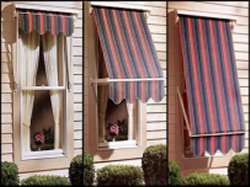window awning

Window awnings can reduce solar heat gain in the summer by up to 65% on south-facing windows and 77% on west-facing windows. You can use an awning to shade one window or have an awning custom-made to shade the entire side of your house.
In the past, most awnings were made of metal or canvas, which need to be re-covered every five to seven years. Today, awnings are made from synthetic fabrics – such as acrylic and polyvinyl laminates – that are water-repellent and treated to resist mildew and fading. Whatever the fabric, you should choose one that is opaque and tightly woven. A light-colored awning will reflect more sunlight.
Awnings require ventilation to keep hot air from becoming trapped around the window. Grommets (eyelets) or other openings along the tops and sides of an awning can provide ventilation. The awning may also open to the sides or top to vent hot air.
A small, horizontal awning will completely shade a south-facing window during the summer. An east- or west-facing window needs an awning that extends down to cover a large percentage of the window. Sideless awnings, called Venetian awnings, can be adjusted as the angle of the sun changes. Venetian awnings, however, are usually not effective at blocking direct sunlight on south-facing windows. Hood awnings with sides added to block out additional sun are more effective. Hip awnings project out and down to accommodate casement windows that open outward.
You can roll up adjustable or retractable awnings in the winter to let the sun warm the house. New hardware, such as lateral arms, makes the rolling up process quite easy. See all window coverings and treatments.
